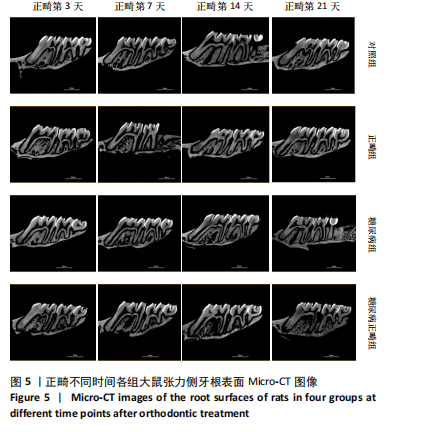[1] 中华医学会糖尿病学分会.中国2型糖尿病防治指南(2020年版)(上)[J].中国实用内科杂志,2021,41(8):668-695.
[2] 周瑞雯,郭华,任忠英.青少年2型糖尿病国外研究进展的相关解读[J].糖尿病新世界,2023,26(7):194-198.
[3] PABISCH S, AKABANE C, WAGERMAIER W, et al. The nanostructure of murine alveolar bone and its changes due to type 2 diabetes. J Struct Biol. 2016;196(2): 223-231.
[4] ZHU L, ZHOU C, CHEN S, et al. Osteoporosis and Alveolar Bone Health in Periodontitis Niche: A Predisposing Factors-Centered Review. Cells. 2022;11(21): 3380.
[5] ZHAO P, XU A, LEUNG WK. Obesity, Bone Loss, and Periodontitis: The Interlink. Biomolecules. 2022;12(7):865.
[6] MAYTA-MAYORGA M, GUERRA-RODRÍGUEZ V, BERNABE-ORTIZ A. Association between type 2 diabetes and periodontitis: a population-based study in the North Peru. Wellcome Open Res. 2024;9:562.
[7] 关禹哲,蒋玉坤,吴祖平,等.机械敏感离子通道Piezo1在糖尿病大鼠牙移动过程中的表达和功能研究[J]. 口腔医学,2022,42(6):487-493.
[8] 孙慧颖,王东旭,张莹.糖尿病患者牙周病的正畸治疗对牙周状况及血糖水平的影响[J].糖尿病新世界,2019,22(9):183-184.
[9] SUN J, DU J, FENG W, et al. Histological evidence that metformin reverses the adverse effects of diabetes on orthodontic tooth movement in rats. J Mol Histol. 2016;48(2):73-81.
[10] SANTAMARIA-JR M, BAGNE L, ZANIBONI E, et al. Diabetes mellitus and periodontitis: Inflammatory response in orthodontic tooth movement. Orthod Craniofac Res. 2019;23(1):27-34.
[11] ARITA K, HOTOKEZAKA H, HASHIMOTO M, et al. Effects of diabetes on tooth movement and root resorption after orthodontic force application in rats. Orthod Craniofac Res. 2016;19(2):83-92.
[12] PLUT A, SPROGAR Š, DREVENŠEK G, et al. Bone remodeling during orthodontic tooth movement in rats with type 2 diabetes. Am J Orthod Dentofacial Orthop. 2015;148(6):1017-1025.
[13] JEON HH, TEIXEIRA H, TSAI A. Mechanistic Insight into Orthodontic Tooth Movement Based on Animal Studies: A Critical Review. J Clin Med. 2021; 10(8):1733.
[14] DING X, LAI L, JIA Y, et al. Effects of chronic fluorosis on the expression of VEGF/PI3K/AKT/eNOS in the gingival tissue of rats with orthodontic tooth movement. Exp Ther Med. 2024;27(3):121.
[15] LI Y, ZHAN Q, BAO M, et al. Biomechanical and biological responses of periodontium in orthodontic tooth movement: up-date in a new decade. Int J Oral Sci. 2021;13(1):20.
[16] GUO X, SHEN Y, DU T, et al. Elevations of N-Terminal Mid-Fragment of Osteocalcin and Cystatin C Levels are Associated with Disorders of Glycolipid Metabolism and Abnormal Bone Metabolism in Patients with Type 2 Diabetes Mellitus Complicated with Osteoporosis. J Physiol Investig. 2024;67(6):335-343.
[17] 冯智敏,吴永生,闫桂艳.糖尿病大鼠正畸牙齿移动及组织学变化[J].现代口腔医学杂志,2007,21(2):188-191.
[18] LI M, SUN H, CHEN H, et al. Type 2 diabetes and bone mineral density: A meta-analysis and systematic review. Medicine (Baltimore). 2024;103(45):e40468.
[19] ZHAO Q, LI Y, ZHANG Q, et al. Association between serum insulin-like growth factor-1 and bone mineral density in patients with type 2 diabetes. Front Endocrinol (Lausanne). 2024;15:1457050.
[20] MURRAY CE, COLEMAN CM. Impact of Diabetes Mellitus on Bone Health. Int J Mol Sci. 2019;20(19):4873.
[21] PSACHNA S, CHONDROGIANNI ME, STATHOPOULOS K, et al. The effect of antidiabetic drugs on bone metabolism: a concise review. Endocrine. 2024. doi: 10.1007/s12020-024-04070-1..
[22] 郭莉莉,张莹,潘多.胰岛素控制对糖尿病大鼠正畸牙齿移动的影响[J].糖尿病新世界,2019,22(9):23-24.
[23] ABBASSY MA, WATARI I, BAKRY AS, et al. Calcitonin and vitamin D3 have high therapeutic potential for improving diabetic mandibular growth. Int J Oral Sci. 2016;8:39-44.
[24] MADDALONI E, NGUYEN M, SHAH SH, et al. Osteoprotegerin, Osteopontin, and Osteocalcin Are Associated With Cardiovascular Events in Type 2 Diabetes: Insights From EXSCEL. Diabetes Care.2024:dc241455. doi:10.2337/dc24-1455.
[25] ELAMIR Y, GIANAKOS AL, LANE JM, et al. The Effects of Diabetes and Diabetic Medications on Bone Health. J Orthop Trauma. 2020;34(3):e102-e108.
[26] HUANG D, HE Q, PAN J, et al. Systemic immune-inflammatory index predicts fragility fracture risk in postmenopausal anemic females with type 2 diabetes mellitus: evidence from a longitudinal cohort study. BMC Endocr Disord. 2024; 24(1):256.
[27] SHEU A, GREENFIELD JR, WHITE CP, et al. Assessment and treatment of osteoporosis and fractures in type 2 diabetes. Trends Endocrinol Metab. 2022; 33(5):333-344.
[28] ZHANG YS, ZHENG YD, YUAN Y, et al. Effects of Anti-Diabetic Drugs on Fracture Risk: A Systematic Review and Network Meta-Analysis. Front Endocrinol (Lausanne). 2021;12:735824.
[29] MARIN C, TUTS J, LUYTEN FP, et al. Impaired soft and hard callus formation during fracture healing in diet-induced obese mice as revealed by 3D contrast-enhanced computed tomography imaging. Bone. 2021;150:116008.
[30] SÁBADO-BUNDÓ H, SÁNCHEZ-GARCÉS MÁ, GAY-ESCODA C. Bone regeneration in diabetic patients. A systematic review. Med Oral Patol Oral Cir Bucal. 2019; 24(4):e425-e432.
[31] LUONG A, TAWFIK AN, ISLAMOGLU H, et al. Periodontitis and diabetes mellitus co-morbidity: A molecular dialogue. J Oral Biosci. 2021;63(4):360-369.
[32] LI Y, HUANG Z, PAN S, et al. Resveratrol Alleviates Diabetic Periodontitis-Induced Alveolar Osteocyte Ferroptosis Possibly via Regulation of SLC7A11/GPX4. Nutrients. 2023;15(9):2115.
[33] ZHAO P, YUE Z, NIE L, et al. Hyperglycaemia-associated macrophage pyroptosis accelerates periodontal inflamm-aging. J Clin Periodontol. 2021;48(10):1379-1392.
[34] CAI F, LIU Y, LIU K, et al. Diabetes mellitus impairs bone regeneration and biomechanics. J Orthop Surg Res. 2023;18(1):169.
[35] BRAGA SM, TADDEI SR, ANDRADE JR I, et al. Effect of diabetes on orthodontic tooth movement in a mouse model. Eur J Oral Sci. 2011;119:7-14.
[36] LI X, ZHANG L, WANG N, et al. Periodontal ligament remodeling and alveolar bone resorption during orthodontic tooth movement in rats with diabetes. Diabetes Technol Ther. 2010;12:65-73.
[37] VILLARINO ME, LEWICKI M, UBIOS AM. Bone response to orthodontic forces in diabetic Wistar rats. Am J Orthod Dentofacial Orthop. 2011;139(4 Suppl):S76-82.
[38] FERREIRA CL, DA ROCHA VC, DA SILVA URSI WJ, et al. Periodontal response to orthodontic tooth movement in diabetes-induced rats with or without periodontal disease. J Periodontol. 2018;89(3):341-350.
[39] CHAPPLE IL, GENCO R; Working group 2 of the joint EFP/AAP workshop. Diabetes and periodontal diseases: consensus report of the joint EFP/AAP workshop on periodontitis and systemic diseases. J Periodontol. 2013;84(4 Suppl):S106-S112.
[40] ZHANG L, LI X, BI LJ. Alterations of collagen-I, MMP-1 and TIMP-1 in the periodontal ligament of diabetic rats under mechanical stress. J Periodontal Res. 2011;46(4):448-455. |










